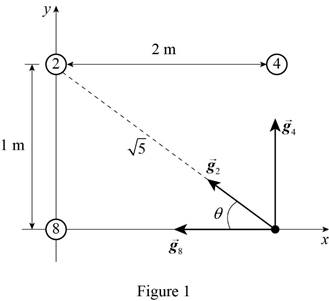
Concept explainers
Three billiard balls, the two-ball, the four-ball, and the eight-ball, are arranged on a pool table as shown in Figure P7.26. Given the coordinate system shown and that the mass of each ball is 0.150 kg, determine the gravitational field at
The gravitational field at
Answer to Problem 41PQ
The gravitational field at
Explanation of Solution
The following figure gives the direction of field vectors.

The point at which gravitational field is to be calculated is identified as
Use figure1, calculate the distance between two-ball and point at which field has to be calculated.
Here,
Use figure1, to calculate angle
Here,
Write the expression for the gravitational field at a point due to a mass
Here,
Use equation (I) to write expression for the gravitational field at
Use equation (I) to write expression for the gravitational field at
Use equation (I) to write expression for the gravitational field at
Use figure1, to calculate direction of field vector due to eight-ball.
Use figure1, to calculate direction of field vector due to two-ball.
Use figure1, to calculate direction of field vector due to four-ball.
Substitute
Write the expression for the total field at
Conclusion:
Substitute
Substitute
Substitute
Substitute
Therefore, the gravitational field at
Want to see more full solutions like this?
Chapter 7 Solutions
EBK PHYSICS FOR SCIENTISTS AND ENGINEER
- How to solve this, given answerarrow_forwardThree point-like charges are placed at the corners of a square as shown in the figure, 28.0 cm on each side. Find the minimum amount of work required by an external force to move the charge q1 to infinity. Let q1=-2.10 μC, q2=+2.40 μС, q3=+3.60 μC.arrow_forwardA point charge of -4.00 nC is at the origin, and a second point charge of 6.00 nC is on the x axis at x= 0.820 mm . Find the magnitude and direction of the electric field at each of the following points on the x axis. x2 = 19.0 cmarrow_forward
- Four point-like charges are placed as shown in the figure, three of them are at the corners and one at the center of a square, 36.0 cm on each side. What is the electric potential at the empty corner? Let q1=q3=+26.0 µС, q2=-28.0 μC, and q4=-48.0μc Varrow_forwardPLS HELparrow_forwardPlease solve and answer the question correctly please. Thank you!!arrow_forward
 Physics for Scientists and Engineers: Foundations...PhysicsISBN:9781133939146Author:Katz, Debora M.Publisher:Cengage Learning
Physics for Scientists and Engineers: Foundations...PhysicsISBN:9781133939146Author:Katz, Debora M.Publisher:Cengage Learning Principles of Physics: A Calculus-Based TextPhysicsISBN:9781133104261Author:Raymond A. Serway, John W. JewettPublisher:Cengage Learning
Principles of Physics: A Calculus-Based TextPhysicsISBN:9781133104261Author:Raymond A. Serway, John W. JewettPublisher:Cengage Learning Classical Dynamics of Particles and SystemsPhysicsISBN:9780534408961Author:Stephen T. Thornton, Jerry B. MarionPublisher:Cengage Learning
Classical Dynamics of Particles and SystemsPhysicsISBN:9780534408961Author:Stephen T. Thornton, Jerry B. MarionPublisher:Cengage Learning University Physics Volume 1PhysicsISBN:9781938168277Author:William Moebs, Samuel J. Ling, Jeff SannyPublisher:OpenStax - Rice University
University Physics Volume 1PhysicsISBN:9781938168277Author:William Moebs, Samuel J. Ling, Jeff SannyPublisher:OpenStax - Rice University Physics for Scientists and Engineers with Modern ...PhysicsISBN:9781337553292Author:Raymond A. Serway, John W. JewettPublisher:Cengage Learning
Physics for Scientists and Engineers with Modern ...PhysicsISBN:9781337553292Author:Raymond A. Serway, John W. JewettPublisher:Cengage Learning College PhysicsPhysicsISBN:9781305952300Author:Raymond A. Serway, Chris VuillePublisher:Cengage Learning
College PhysicsPhysicsISBN:9781305952300Author:Raymond A. Serway, Chris VuillePublisher:Cengage Learning





